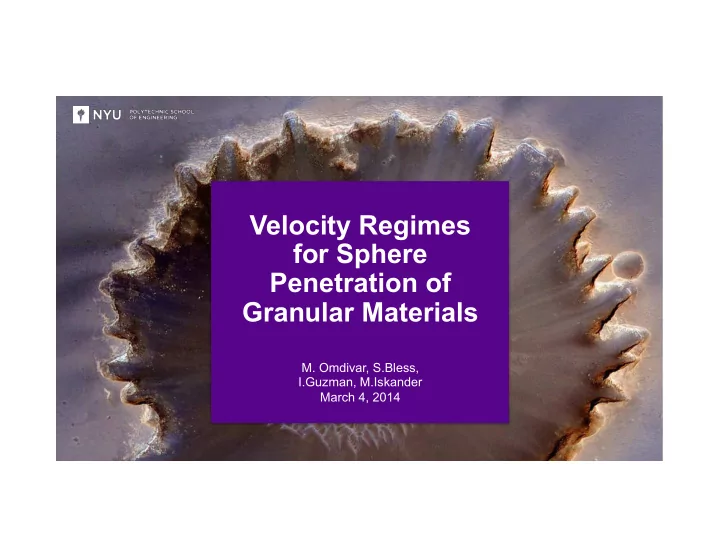

Velocity Regimes for Sphere Penetration of Granular Materials M. Omdivar, S.Bless, I.Guzman, M.Iskander March 4, 2014
Experiments Experiments were conducted to measure deceleration during penetration of granular materials. There were two materials: ground fused quartz or silica sand. Three types of saturation: dry, oil (for quartz) and water (for sand). For most materials, there were two different relative densities. Projectiles were either spheres (10 or 12 mm) or hemispherical-nose rods (10 mm) Velocities were up to 300 m/s, achieved with compressed gas guns.
Measurements of V(t) A PDV was used to measure V(t) • This is a doppler device, based on heterodyning with a laser source. Its features include a very large DoF and dynamic range. • Spherical projectiles, 14 mm. • Projectiles could be observed through cavity • From V(t) integrate to get V(x) or differentiate to get dV/dt. 3
Measurements of x(V) Phenomenology shown by DOP experiments measured DOP experiment conducted p(V). near a window. • Spherical projectiles: made from Al, steel, or WC. • Penetration measured by recovery. • Data: penetration (x) vs V. • Estimate: Δ V/ Δ t ≅ <V> ( Δ V/ Δ x) . . 4
Measurements of x(t) High speed camera used to measure x(t) during penetration. • Hemispherical or conical nosed rod the a sting on the back. • X(t) data double differentiated to give dV/dt. . . 5
Comparing materials The PDV results can be used to directly compare penetration resistance of different materials. • Steeper curves mean greater penetration resistance. • Resistance increases with density. • Resistance decreases with saturation. • Resistance is higher for sand than for quartz • For saturated materials, signal was lost at 6 about 50 m/s.
Calculation of acceleration For sand there are apparently three velocity regimes. • Deceleration is very high during embedment and shock formation. • Deceleration inversely proportional to V for V>V c ≈ 100 m/s. • Below V c deceleration proportionality increases, but then becomes nearly constant. Acceleration for loose dry sand. 7 .
Penetration resistance For each experiment, Dense quartz penetration resistance is computed. Loose sand • Force on projectile, F = M dV/dt • Average penetration resistance over hemisphere = F/A Dense sand • This is also the stress that the projectile exerts on the sand. • Max values are 70 – 110 MPa. . 8
Implications for penetration depth An practical implication of these DOP data for results is that for sand spheres penetration, there is little advantage to shooting >100 m/s. • This is borne out by various studies of penetration of spheres and rods as a function of Decelera- velocity. tion of W rods in • The reason is that the force resisting sand (Bless et penetration increases approx as V 2 . al) • Most penetration takes place at low velocity. 9
Instantaneous Drag Coefficient • Based on MdV/dt = ½ρ CAV 2 . • Variability shows deviation from simple inertial resistance. . • Thus the usual assumption that at high velocities resistance is due to inertia or dynamic friction is not correct. • The “drag coefficient” has local maximum at V 0 . . Loose and dense sand . penetrated by spheres. 10
Instantaneous Drag Coefficient For sand penetrated by a conical nose rod: V(t) High C at low velocities arises because deceleration becomes nearly constant, meaning resistance is due to friction, not inertia (and C ≈ 1/V 2 ). C(V) • . . 11
Interpretation of critical velocity This is the velocity beyond Kovtov hypothesis: for V>V c , which there is large scale sand becomes stronger as comminution of the sand. pores are crushed out. It becomes possible to form a false nose that makes . penetration easier. . 12
Summary wrt Penetration Resistance Depends on material Sand is harder than quartz. Dry materials are harder than wet materials. Resistance increases with density. * Depends on velocity wrt a critical value Critical velocity has highest drag coefficient. Behavior for V>V c Resistance increases almost as V 2 , e.g. inefficient penetration. Behavior for V<V c C increases with velocity. Behavior as V goes to zero. Resistance becomes frictional. 13
Recommend
More recommend